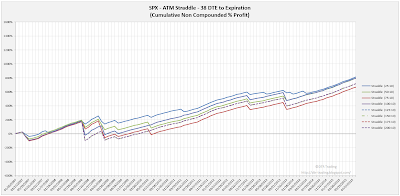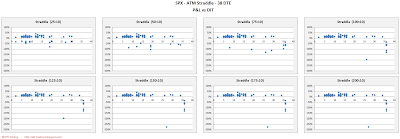For background on the setup for the backtests, as well as the nomenclature used in the charts and tables below, please see the introductory article for this series: Option Straddle Series - P&L Exits.
No IV Rank Filter
In this section we will look at the results of entering one trade for every monthly expiration regardless of the implied volatility (IV) rank of the SPX on the date of entry. Entering these trades at 38 DTE and utilizing our loss exits and 10% credit exits (described here), resulted in the equity curves below.
 |
| (click to enlarge) |
The trade metrics for these different exits are shown in the table below. The (25:10) variation stands out with the highest P&L % / day reading, highest overall P&L %, and a decent win rate...although not the highest in the group.
 |
| (click to enlarge) |
The table below shows the distribution of returns in five-number summary format. Hat-tip to tastytrade.
 |
| (click to enlarge) |
Below are three sets of scatter plots for selling 38 DTE ATM SPX straddles. The first image contains one scatter plot per strategy and shows P&L in percentage terms versus IV rank for the SPX. The IV rank was captured on the day each trade was initiated. There is a clear trend of increasing P&L with increasing IV rank.
 |
| (click to enlarge) |
The next image shows P&L in percentage terms versus initial ATM IV. This ATM IV was captured on the day each trade was initiated. Higher IV resulted in higher returns, but the majority of the profitable trades occurred at lower IV.
 |
| (click to enlarge) |
The third image shows P&L in percentage terms versus days-in-trade (DIT). When managing losses early (25%, 50%), the losses were fairly evenly distributed across DIT. As the loss management becomes less aggressive, we see that the losses are concentrated above 25 DIT...interesting!
 |
| (click to enlarge) |
IV Rank > 50% Filter
In this section we will look at the results of entering one trade for every monthly expiration only when the IV rank of the SPX is greater than 50% ( >50% ). Entering these trades at 38 DTE and utilizing our loss exits and 10% credit exits (described here) resulted in the equity curves below.
 |
| (click to enlarge) |
The trade metrics for these different exits are shown in the table below. There are significantly fewer trades that meet the >50% IVR criteria, but the P&L% per day readings are much higher at the lower loss levels (25%, 50%)
 |
| (click to enlarge) |
The table below shows the distribution of returns in five-number summary format.
 |
| (click to enlarge) |
IV Rank < 50% Filter
In this section we will look at the results of entering one trade for every monthly expiration only when the IV rank of the SPX is less than 50% ( <50% ). Entering these trades at 38 DTE and utilizing our loss exits and 10% credit exits (described here) resulted in the equity curves below.
 |
| (click to enlarge) |
The trade metrics for these different exits are shown in the table below. Using the lower IVR filter increased our win rate for the trades utilizing the larger loss exits, resulted in larger profit factor readings, and solid total P&L numbers....very interesting!
 |
| (click to enlarge) |
The table below shows the distribution of returns in five-number summary format.
 |
| (click to enlarge) |
In the next post we will look at the backtest results of 38 DTE ATM SPX short straddles using the same loss thresholds as above, but with profit taking occurring at 25% of the credit received.
You can follow my blog by email, RSS or Twitter. All options are free, and are available on the top of the right hand navigation column under the headings "Subscribe To RSS Feed", "Follow By Email", and "Twitter". I follow blogs by RSS using Feedly, but any RSS reader will work.
2 comments:
You have something here that Tastytrade doesn't have yet, a strategy that works well in Low IV, and Low IV Rank. Selling straddles with a 10% profit, and getting out at 25-200% seems to work well in Low IV pretty consistently. Looking at the 45 days, this seems to be relatively consistent there too. I wonder if it would benefit them to see some of your work here on this.
Thanks Yoshi.
That variation does look pretty good doesn't it. As we move to higher DTE, there are other variations that work surprisingly well too...there are some very high P&L numbers with the higher DTE trades that I'll show in the coming weeks.
I have shared my work with Tom S at TT and he has forwarded my work to his research team. I've traded a number of emails with them since April of this year. I'm not sure if they follow my blog though.
Thanks,
Dave
Post a Comment